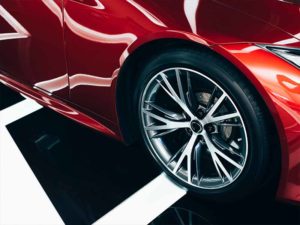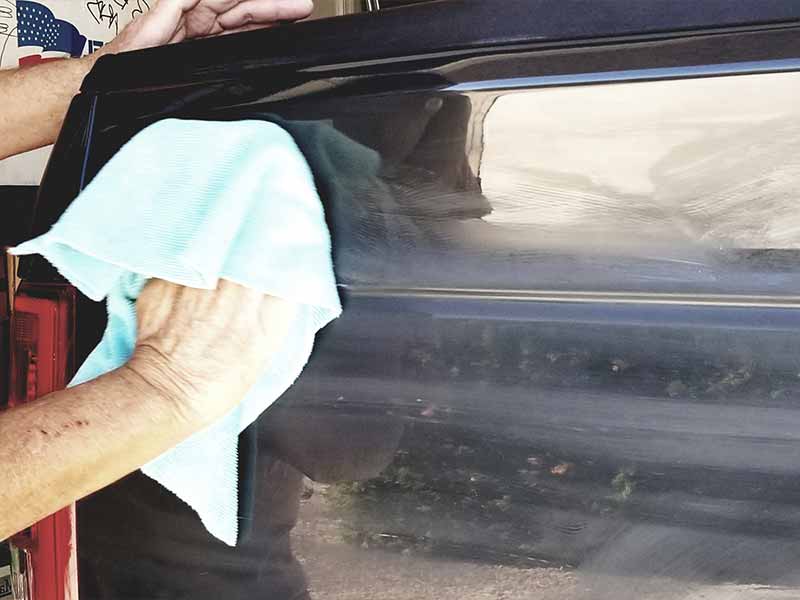Table of Contents
- Forced Rotation Vs Free Spinning Polishers
- The Role of a Polisher
- What Is Forced Rotation?
- What Is a Free Spinning Polisher?
- Benefits of Forced Rotation Polishers
- Drawbacks of Forced Rotation Polishers
- Benefits of Free Spinning Polishers
- Which Tool Is Right for You?
- Drawbacks of Free Spinning Polishers
- Helpful Links
- Conclusion
When it comes to polishers, you have a lot of choices to make. One of the bigger selections is whether you’ll use a forced rotation or free spinning polisher. If you’re not sure what these are, you came to the right place.
In this piece, we’ll be discussing everything you need to know about forced rotation and free spinning polishers. We’ll cover some definitions, benefits, and drawbacks for both of these polishers. The goal is to help you pick the right option for your DIY detailing project.
Forced Rotation Vs Free Spinning Polishers
If you’re a little more experienced and looking for more cutting power, a forced rotation polisher is the right choice. It has more room for error, but the cutting power is unmatched. If you want a tool that’s easier to use, especially for extended periods of time, then you should grab a free spinning polisher. These result in less muscle strain and are more user-friendly for beginners.The Role of a Polisher
A polisher is one of the most important pieces of equipment for any detailer — DIY, professional, or otherwise. A polisher is a mechanized tool that has a head on it. The head will rotate and spin, and is used to attach a polishing pad.
The pad will come in contact with your car and apply whatever solution you’re using. Different pads are used for different functions, and they have corresponding solutions. The same polisher can be used to apply a mirror-like finish on your car or to remove minor scratches, the only difference is the pad, solution, and speed used to run your polisher.
If you’re looking to semi-regularly detail your personal car, then a polisher is critical. Within the full spectrum of automotive detailing, a polisher will help with almost every step aside from washing and clay barring.
A polisher will get you results that are better, more efficient, and take less time. Trying to do the same tasks by hand can easily take double or triple the time it takes to achieve the same with an automated polisher.
As we describe forced rotation and free spinning polishers, one thing is going to be changing: how the head is affixed to the polisher. As you keep reading, keep this idea in mind and remember that the head is the part in which the polishing pad connects. The head is responsible for how the pad acts and reacts while you polish your car.
What Is Forced Rotation?
A forced rotation polisher uses a separate gear to spin the pad you attach to the machine’s head. This option can be found as either a dual-action polisher or a traditional orbital polisher.
This added gear works well for a number of reasons. For one, it allows you to apply more pressure to the pad. With a free spinning polisher, the head will jam up and stop if you press too hard.
Since a forced rotation polisher has this added gear, the pad is forced to keep spinning, despite the added pressure.
It’s also important to understand that this gear is directly driven by the motor. A free spinning polisher uses the machine’s motor to only rotate the head, not the pad.

What Is a Free Spinning Polisher?
A free spinning polisher is the more traditional version of dual-action polishers. In this style, the pad is not being forced to spin around. Instead, the pad spins as a result of the motion of the pad.
A dual-action polisher uses a counterweight and an offset pad. Since the pad isn’t centered, it spins in an elliptical pattern. This, coupled with the counterweight causes the pad to spin in an always-changing ellipse — almost like a planet’s orbit around the sun.
The pad is connected to the polisher using a fixed axle. This axle isn’t forced to spin at all. It’s actually the act of moving in these quick, tight ellipses that causes the pad to rotate at all.
You can tell that a dual-action polisher is free spinning if you apply some extra pressure to the pad. You’ll notice that the pad can still jiggle around, but it won’t rotate at all. Since it doesn’t have the added direct-driven gear that a forced rotation polisher has, the pad will stop rotating altogether.
Benefits of Forced Rotation Polishers
First up, let’s talk about some of the major benefits of using a forced rotation polisher. Remember, these points will have to do with the fact that this type of polisher’s pad is always being forced to spin.
More Cutting Power
Since the pad is constantly spinning no matter how hard you press down, you’ll achieve more cutting power. Cutting power is a phrase that refers to how deep into your topcoat you can polish.
When you’re looking to get rid of swirls and scratches, you’ll be relying on your tool’s cutting power. More cutting ability will allow you to remove deeper scratches and make them disappear from your car.
In other words, you should stick with a forced rotation polisher if your goal is to get rid of stubborn scratches.
Easier to Use
These pads are also easier for beginners to use. Why? It’s all due to the fact that the pad won’t slow down due to user error.
With a free spinning polisher, the machine might skip along the surface as you press down too hard or the pad isn’t held flat against your car. With a forced rotation polisher, the tool is more forgiving.
Instead, you can vary the pressure you use and hold the pad at an angle, and the tool will keep spinning. Of course, you want to avoid doing this in general if you want the best results, but it’s nice to have a tool that gives you more wiggle room during the learning process.
Allows the Use of Larger Pads
Certain polishers will be limited to how large the pad can be. With a free spinning polisher, larger pads can’t be effectively spun on the tool.
This means that you would need to stick to smaller pads. Smaller pads will take you longer to polish your car and will limit what types of projects you can do.
With a polisher that forces the pad to spin, you don’t have to worry about this at all. The pad will spin, regardless of how large it is (within reason).
More importantly, the pad will spin at a constant velocity so you can get a uniform polish across your car.

Drawbacks of Forced Rotation Polishers
There are some downsides that should be considered before picking up a forced rotation polisher. These might be deal-breakers to some users, so keep them in mind as you start shopping for the perfect polisher.
More Muscle Fatigue
One of the bigger downsides of using a forced rotation polisher is the added strain on your arms while you use it. The simple fact is that you’ll experience more muscle fatigue with this polisher.
It has to do with the fact that the pad is constantly being spun. In that regard, it’s a lot like a less powerful jackhammer going off. It’s common for users to get tingling sensations in their arms and hands after using a forced rotation polisher — especially if they used it for a long time.
This becomes more apparent as you work over uneven surfaces, apply extra pressure, or apply the pad in a non-parallel manner.
The simple solution to this problem is to be mindful of how long you use the polisher for. Taking frequent breaks is a great way to minimize the level of fatigue you feel while polishing your car.
Polisher Tends to “Walk”
Another problem is that these polishers tend to “walk” along your car. This is especially true with beginner users.
When a polisher “walks”, it is moving away from the direction you’re trying to push it. It will feel like the polisher is going wherever it wants to.
In this case, it happens due to the forced rotation of the pad. If there are uneven surfaces to the car, then the higher surfaces will apply more friction to the pad, causing it to kick the machine out and walk it towards the high surface.
This phenomenon is very common and you will better understand it once you use a polisher enough. A walking tool isn’t going to ruin your polishing project, but it can get annoying and might catch a beginner off-guard.
Easy to Over-Do it and Ruin Your Topcoat
You’ll need to use a more delicate touch for a forced rotation polisher. Overdoing it can cause you to ruin your topcoat.
Remember, your topcoat is a delicate and sensitive thin layer of lacquer. If you apply too much heat, then the topcoat can simply melt away or you can cut too deep into it.
A forced rotation polisher is constantly spinning the pad. The pad and added compounding solution both have a certain level of friction. As you push on the pad and it keeps spinning, this friction becomes more troublesome.
With enough pressure and time, you can melt off your topcoat and cause damage that’s expensive and time-consuming to fix.
In other words, it’s easier to mess things up with a forced rotation polisher.
Benefits of Free Spinning Polishers
Next up, let’s talk about free spinning polishers. These are dual-action polishers that rely on the pad’s odd motion to result in spinning. We’ll start by talking about some of the benefits of this type of polisher.
Gentler on Your Arms
Since the rotation is less violent and not forced, this type of polisher is a lot more gentle on your arms as you use it. Modern dual-action polishers will focus on minimizing the vibration you feel and keeping the tool quieter.
This means that you can use a free spinning polisher for hours on end without getting the same tingling sensation or muscle fatigue that you would feel with a forced rotation polisher.
Safer on Your Paint
In addition, free spinning polishers are much more gentle on your car’s topcoat. That delicate layer of clear coat doesn’t have to worry about the added friction and pressure associated with forced rotation polishers.
As a result, you don’t have to worry about melting your topcoat away as you go through your polishing project. This gives most users added peace of mind as they work across their car.
Forces You to Use Perfect Pressure
What happens when you push a free spinning polisher too hard? It stops spinning. This is a nice visual indicator that you’re applying too much pressure.
With this level of pressure sensitivity, users will be forced to apply the perfect amount of pressure while they use a free spinning polisher.
We always mention that polishing your car is all about consistency in the pressure you apply and speed you move the polisher. With this style of polisher, one of those two factors is automatically accounted for.

Which Tool Is Right for You?
How are you supposed to decide between these two tools? It’s all a matter of personal preference. Either of these polisher styles will work perfectly for your upcoming projects. The major differences lie in how easy the polisher is to use and how much cutting power you get.
If you’re a little more experienced and looking for more cutting power, a forced rotation polisher is the right choice. It has more room for error, but the cutting power is unmatched.
If you want a tool that’s easier to use, especially for extended periods of time, then you should grab a free spinning polisher. These result in less muscle strain and are more user-friendly for beginners.
There’s also an ability to own both polishers. In a professional detailing garage, you’ll see the pros swap between different polishers as they do different projects. This is because every tool has a specific intended use, and these professionals know how to get the most high-quality results efficiently. That means picking the right tool for the job.
Drawbacks of Free Spinning Polishers
Finally, let’s discuss some drawbacks that people will often notice while using a free spinning polisher. Again, consider these points before you purchase a polisher for yourself.
Less Cutting Power
The bottom line is that a free spinning polisher simply can’t cut as deep as a forced rotation polisher can. If you try to add extra muscle and friction to your polisher, it will just stop spinning (resulting in zero cutting power).
This drawback will only matter if you’re looking to do serious cutting, likely with a wool pad and deep-cutting compounding solution. If you’re just looking to polish, wax, or finish your vehicle, then you don’t have to worry about the lessened cutting power.
Can Cause Buffer Trails
Also called holograms, swirls, or ghosting, buffer trails can be annoying. They leave your car looking glazed.
This can be due to a number of factors, but most of them have to do with misusing a polishing tool.
With a free spinning polisher, pushing too hard will cause the pad to lock up and not spin. Instead of getting rid of defects, this will just cause buffer trails in certain parts of your car.
To get rid of these, you’ll typically have to go over your car again with the polisher. Essentially, you’ll double the amount of time and effort required to do a single polishing job.
Helpful Links
Conclusion
As you just learned, there are some big differences between forced rotation and free spinning polishers. We also outlined the benefits and drawbacks of either style along with some help picking the right tool.
If you want more DIY detailing guides and tips, explore the rest of our blog.









